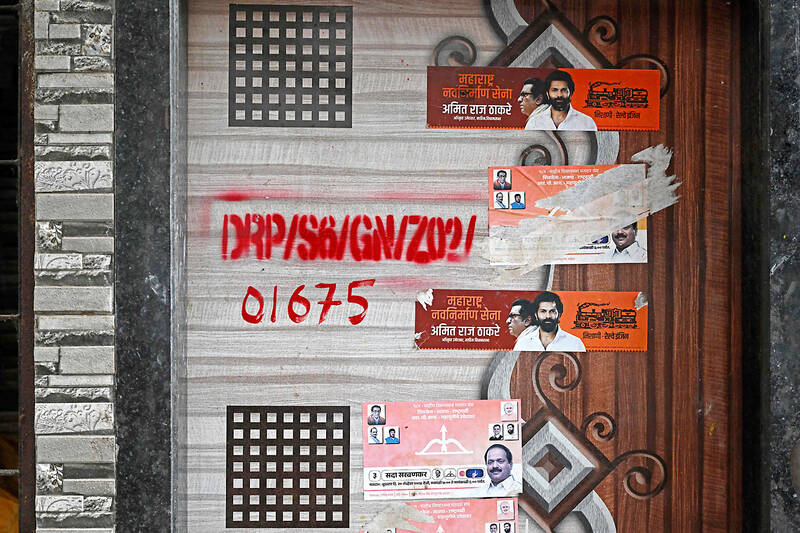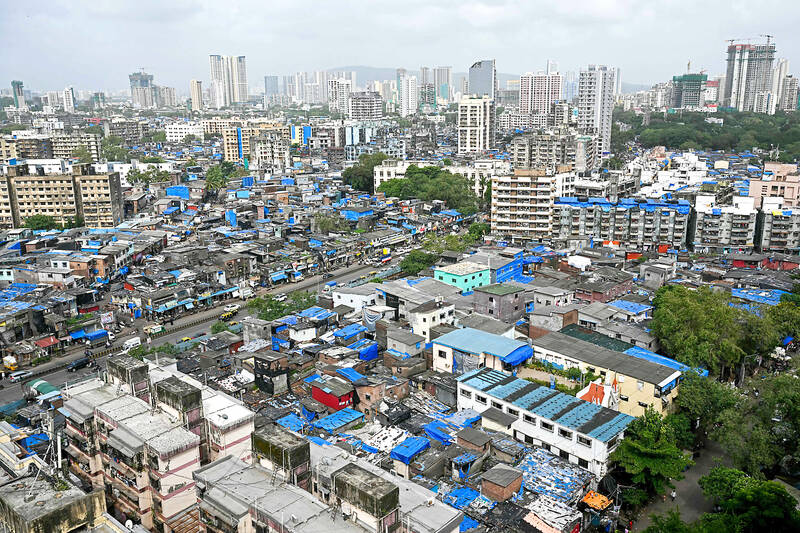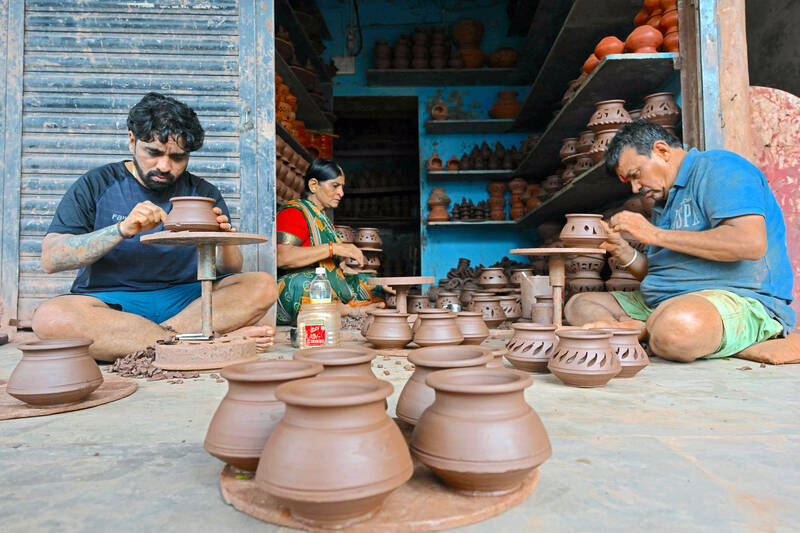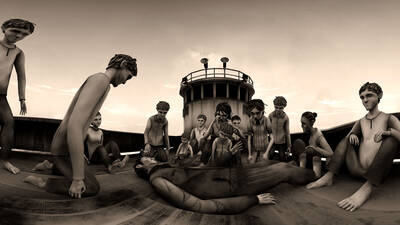Stenciled just above the stairs, the red mark in Mumbai’s Dharavi slum is tantamount to an eviction notice for residents like Bipinkumar Padaya.
“I was born here, my father was born here, my grandfather was born here,” sighed the 58-year-old government employee.
“But we don’t have any choice, we have to vacate.”

Photo: AFP
Soon, bulldozers are expected to rumble into Asia’s largest slum, in the heart of the Indian megalopolis of Mumbai, flattening its labyrinth of filthy alleyways for a brand-new neighborhood.
The redevelopment scheme, led by Mumbai authorities and billionaire tycoon Gautam Adani, reflects modern India — excessive, ambitious and brutal.
If it goes ahead, many of Dharavi’s million residents and workers will be uprooted.

Photo: AFP
“They told us they will give us houses and then they will develop this area,” Padaya said.
“But now they are building their own planned areas and trying to push us out. They are cheating us.”
On the fringes of Dharavi, Padaya’s one-storey home is crammed into a tangle of alleys so narrow that sunlight barely filters through.

Photo: AFP
ENGINE ROOM AND UNDERBELLY
Padaya says his ancestors settled in the fishing village of Dharavi in the 19th century, fleeing hunger and floods in Gujarat, 600km to the north.
Waves of migrants have since swelled the district until it was absorbed into Mumbai, now home to 22 million people.
Today, the sprawl covers 240 hectares and has one of the highest population densities in the world — nearly 350,000 people per square kilometer.
Homes, workshops and small factories adjoin each other, crammed between two railway lines and a rubbish-choked river.
Over the decades, Dharavi has become both the engine room and the underbelly of India’s financial capital.
Potters, tanners and recyclers labor to fire clay, treat hides or dismantle scrap, informal industries that generate an estimated US$1 billion annually.
British director Danny Boyle set his 2008 Oscar-winning film Slumdog Millionaire in Dharavi — a portrayal that residents call a caricature.
For them, the district is unsanitary and poor — but full of life.
“We live in a slum, but we’re very happy here. And we don’t want to leave,” said Padaya.
‘CITY WITHIN A CITY’
A five-minute walk from Padaya’s home, cranes tower above corrugated sheets shielding construction. The redevelopment of Dharavi is underway — and in his spacious city-center office, SVR Srinivas insists the project will be exemplary.
“This is the world’s largest urban renewal project,” said the chief executive of the Dharavi Redevelopment Project (DRP). “We are building a city within a city. It is not just a slum development project.” Brochures show new buildings, paved streets, green spaces, and shopping centers.
“Each single family will get a house,” Srinivas promised. “The idea is to resettle hundreds of thousands of people, as far as possible, in situ inside Dharavi itself.”
Businesses will also remain, he added — though under strict conditions.
Families who lived in Dharavi before 2000 will receive free housing; those who arrived between 2000 and 2011 will be able to buy at a “low” rate.
Newer arrivals will have to rent homes elsewhere.
‘A HOUSE FOR A HOUSE’
But there is another crucial condition: only ground-floor owners qualify.
Half of Dharavi’s people live or work in illegally built upper floors.
Manda Sunil Bhave meets all requirements and beams at the prospect of leaving her cramped two-room flat, where there is not even space to unfold a bed.
“My house is small, if any guest comes, it is embarrassing for us,” said the 50-year-old, immaculate in a blue sari.
“We have been told that we will get a house in Dharavi, with a toilet... it has been my dream for many years.”
But many of her neighbors will be forced to leave.
Ullesh Gajakosh, leading the “Save Dharavi” campaign, demands “a house for a house, a shop for a shop.” “We want to get out of the slums... But we do not want them to push us out of Dharavi in the name of development. This is our land.”

Using dating apps to find love is commonplace these days — and yet, for many singles, it has become a double-edged sword. The perks of having a never-ending supply of potential matches at your fingertips are obvious — but the appeal of connecting and meeting with strangers is time-limited. It can be especially frustrating to feel as if you’re stuck at the swiping stage. In 2023, US jeweler Shane Company found that the average American will spend about eight months using dating apps — swiping on around 3,960 profiles — before finding a partner. But for chronic daters, those numbers will

Well, it turns out I finally did live long enough to see everything. Last week Reuters reported on a statement from the American Institute in Taiwan (AIT), America’s officially unofficial representative office in Taipei, that “China intentionally mischaracterises World War II-era documents, including the Cairo Declaration, the Potsdam Proclamation and the Treaty of San Francisco, to try to support its coercive campaign to subjugate Taiwan.” Not only did Reuters forward this crushing rejection of the claims of the People’s Republic of China (PRC), it even correctly represented US policy on Taiwan’s status. The director of the Ma Ying-jeou Foundation, Hsiao

Sept. 29 to OCT. 5 With their compass broken, the small boat carrying 18 South Vietnamese refugees drifted at sea for more than a week, their rations running low. They had all but lost hope of reaching their destination of Manila when a Taiwanese fishing vessel spotted them and eventually brought them to Penghu. It was June 1981, six years after the fall of Saigon, and the group joined the millions who had fled the communist takeover of Vietnam. Taiwan was not a main destination for Vietnamese refugees, but more than 2,100 boat people arriving on 51 vessels passed

The iconic, brightly painted coastal sheds in and around Melbourne, Australia, are a quirky real estate mix: absolute beachfront views, but lacking basic features including a bedroom, bathroom, running water and even power. While they lack homely comforts, some can sell for more than an average Melbourne suburban house. And while the house comes with the security of land title, the shed is built on a public beach. Known variously as beach boxes, bathing boxes and boatsheds, these basic structures have been features of the Victoria state coastline along Port Phillip Bay and Western Port since the 19th century. What they have going